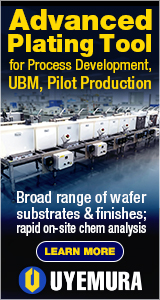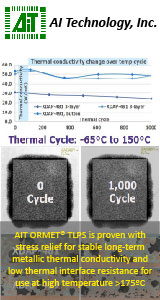|

|
|
| Ask the Experts | |||||||
|
|||||||
|
March 28, 2018 - Updated September 7, 2010 - Originally Posted Most Important Factors for Screen PrintingWhich of these factors is more critical to the solder printing process, solder paste volume or solder print alignment? What factor is key to controlling solder paste volume, stencil aperture opening or machine setup? K. L. |
|||||||
| Expert Panel Responses | |||||||
|
Solder paste volume and solder print alignment are critical to the solder printing process. Depending on the situation, there is no point in having all the paste you need if it is in the wrong place any more than having minimal amount of paste on pad. A small amount of misalignment can be lived with since the solder will pull back to the solderable surface. Excessive misalignment will cause problems. Insufficient paste will case problems weather on pad or slightly off pad. The key factor to control solder paste volume, stencil aperture opening or machine setup depends on the situtation. If the machine setup is significantly away from the process window (which is unique for each solder paste) then the aperture size will be of little help. The same can be said for stencil apertures if the standard design rules on wall area to open area are breached then there is little machine setup can do to help.
Senior Applications Chemist Henkel Electronics Dr. Poole is a Senior Applications Chemist in Henkel Technologies, electronics assembly materials application engineering group. He is responsible for all of Henkel's assembly products including soldering products, underfills, PCB protection materials, and thermally conductive adhesives.
Alignment accuracy between thestencil apertures andthe PCB SMT pads is a key factor in getting consistent print volume with a low standard deviation and high Cpk. The solder paste is pulled from the stencil by the adhesion of the solder paste to the SMT pad. When the stencil apertures and SMT pads are not aligned accurately, part of the solder paste brick is printed off of the SMT pad. This reduces the contact area between the solder paste and the SMT pad and the result is a corresponding reduction in adhesion forces. Minor reductions in adhesion forces will start to increase the standard deviation of the printing process, especially as the SMT pad size gets smaller, and this effects the solder paste volume from print-to-print. Major reductions in adhesion forces will cause poor solder paste volume, poor print definition, and possibly no solder paste deposition at all. Expect alignment accuracy between the stencil and PCB to become even more critical as 01005s, CSPs, and QFNs become more mainstream. When controlling solder paste volume, I am assuming you mean print-to-print. In this case, the stencil aperture opening, combined withfoil thickness, can only determine how much solder paste volume can be potentially deposited. Controlling the solder paste volume from print-to-print is dependent on the stencil, PCB, solder paste, squeegee blade, and printer settings. From your vantage point, the only one you have direct control over is the printer settings.Making adjustments to the printer can compensate for quality issues in the other areas, as long as they are no show stoppers, and be the key factor in making or missing shipment.
V.P. Technology & Engineering Fine Line Stencil, Inc. Robert Dervaes has worked in the electronics industry since 1992 in both design and manufacturing. Over the past 11 years he has established the technical foundation of Fine Line Stencil, Inc. - a premier stencil supplier to the electronics industry.
The short answer to this question is: All four of these factors impact the success/failure of the screen printing process. Both paste volume and print alignment are important. The paste volume determines the success or failure of the solder joint after reflow. Excess volume may result in bridging, solder balling, and tomb stoning of components. Not enough volumes create insufficient solder joints. Both excess and insufficient volumes will require costly rework. Print alignment is a key factor, especially for smaller component technology (fine pitch, micro BGA, 0201, 01005). Registration issues on these small packages will cause solder bridges and solder balls. These issues are intensified with the use of Lead Free solders. When printed off pad, lead free solder will often create solder balls, rather than pulling back to the pad. The stencil apertures are an excellent way to control the volume of paste deposited on the board. The correct combination of aperture design and stencil thickness compensate for lead to pad compatibility issues, and result in robust solder joints when all processes are correct. The machine setup drastically effects the performance of the stencil. The correct combination of print speed, pressure, and snap off ensure proper paste release from the stencil. If any of these are out of adjustment, the paste may not separate properly from the stencil, affecting the volume deposited on the board. The paste deposition is critical. There is still part placement and reflow ahead.
Director Integrated Ideas & Technologies, Inc. Stephanie Nash is the Director of Technical Services & Marketing for Integrated Ideas & Technologies, Inc., a premier manufacturer of SMT stencils. She has been instrumental in the stencil design and technical support.
Solder paste volume and stencil alignment are both key factors to successful screen printing operations. Fortunately these variables can both be controlled by modern stencil printers. Since stencil printing is an on-contact method of solder paste printing, the stencil thickness is the key factor to controlling solder paste volume. You may have areas on your PCB that requires different volumes of solder paste, and these areas can be adjusted by changing the apertures or the stencil thickness in those areas that require modification of the volume. For example, you can use a "step-down" area on your stencil for a fine pitch component or even a larger apertures where you have discrete components that tombstone during reflow. For best results, don't forget to use fresh solder paste that has been properly stored.
Regional Sales Manager OK International Inc. Ed Zamborsky is a Regional Sales & Technical Support Manager for Thermaltronics, located in New York. His position requires frequent customer visits throughout North America and the Caribbean and his position encompasses not only sales but the role of trainer and master applications engineer for all of Thermaltronics products. His expertise includes such specialties as hand soldering, convection and conduction reflow techniques, array rework, fluid dispensing equipment, and fume extraction. Ed has authored many articles and has presented many papers on topics such as; Low Volume SMT Assembly, Solder Fume Extraction, SMT Rework, BGA Rework, Lead-Free Hand Soldering, High Thermal Demand Hand Soldering, Lead Free Visual Inspection and Lead Free Array Rework.
Both paste volume and print alignment are critical parameters in the printing process. IPC 7525 rev A suggest .1 mils per active print image area as a guideline for the maximum amount of miss-alignment of the stencil to the board pads. The stencil aperture design, the stencil, and the machine set up are important in controlling paste volume and paste volume dispersion. The paste print process is a two stage process: the fill process where the aperture is filled with solder paste and the transfer process where the paste releases from the aperture and is transferred to the board pad. Fill depends on squeegee speed, squeegee blade, squeegee pressure, and solder paste. Transfer depends on the stencil wall quality, Area Ratio of the aperture, solder paste, and separation speed.
Vice President Technology Photo Stencil For over 18 years, Dr. Coleman has been the vice president of technology for Photo Stencil, working closely with customers to understand their printing requirements. His efforts have resulted in several new stencil products.
Solder paste volume is less critical than printalignment. My experience shows that apaste deposit can be 50% of the ideal release and still produce a good solderjoint. Problems occur because pasterelease can quickly deteriorate. Pasterelease doesn't drop off gradually. Oneprint will be 100%, the next print 65%, the next 15%. Print alignment affects paste release from stencilapertures. A small aperture may only bemisaligned 15% and only release 25% of the necessary volume. A large aperture may be misaligned 50% andrelease 100% of the necessary volume. Itall comes down to a tug-o-war between PCB adhesion vs stencil walladhesion. The winner is the differencebetween a good or bad solder joint. Goodalignment is the way to help make sure the PCB wins. Aperture size affects the ability of solder paste to bereleased from the stencil. A smallaperture requires close attention to aperture-to-pad alignment and requiresadequate, consistent aperture fill. Adequate fill is controlled with printer settings. Printer settings should be adjusted toachieve consistent aperture fill. As a side note: The smaller the components on the board,the more PCB design must adhere to good DFM guidelines. Remember the following points:
Manufacturing Engineer Benchmark Electronics, Minnesota Division Steve Bowen is a Manufacturing Engineer with knowledge of solder paste printing, stencil design, 3D paste inspection and the P&P process. Steve has 15+ years experience and is an SMTA Certified Engineer.
The solder paste volume will make the difference betweena conforming and a non-conforming solder joint. Insufficient solder and excesssolder are just the 2 extremes of the defects than can have the paste volume asthe root cause. And of course these 2 non-conformities can be caused by solderpaste alignment. Another common defect, the solder bridge, can be caused by thevolume of paste, the paste alignment and upstream in the process (solder pasteviscosity and stencil exposure) and downstream in the process on the pick andplace equipment and reflow. Some of the deviations in the paste deposition (volume orX, Y alignment) will be, to some extent, "compensated" later depending on thesolder paste type and the reflow profile settings that will determine how muchthe surface tension in liquid stage will "pull the solder towards the hotmetallic surfaces (pads and component leads). However, it is not recommended tobet on that, especially with the component dimensions that we have to deal withnow and in the future. Most of the printers have fiducial mark recognition asthe way to align the PCB with the stencil – the higher acceptance criterion forthe fiducial mark, the higher paste deposition accuracy you will get. So,again, it is critical to have a close to perfect print alignment combined witha consistent solder paste release through the stencil. For a consistent solder paste volume, there is a list ofparameters to look into:
Engineering and Operations Management Independent Consultant Georgian Simion is an independent consultant with 20+ years in electronics manufacturing engineering and operations.
Contact me at georgiansimion@yahoo.com. |
|||||||
| Submit A Comment | |||||||
|
Comments are reviewed prior to posting. You must include your full name to have your comments posted. We will not post your email address. |
|
Free Newsletter Subscription
Circuitnet is built for professionals who bear the responsibility of looking ahead, imagining the future, and preparing for it. Insert Your Email Address |
|

|






